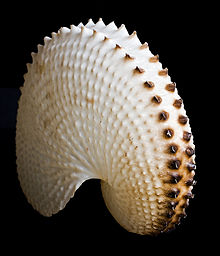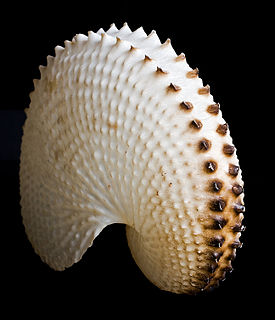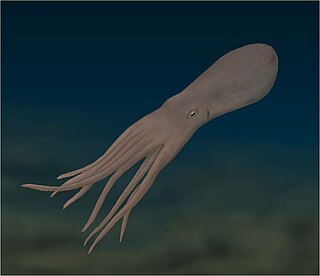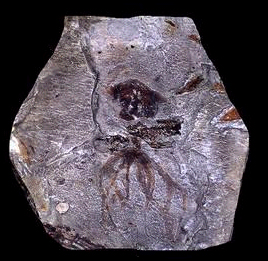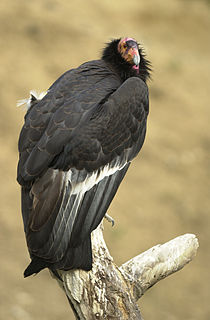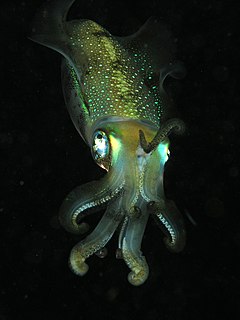
A cephalopod is any member of the molluscan class Cephalopoda such as a squid, octopus or nautilus. These exclusively marine animals are characterized by bilateral body symmetry, a prominent head, and a set of arms or tentacles modified from the primitive molluscan foot. Fishermen sometimes call them inkfish, referring to their common ability to squirt ink. The study of cephalopods is a branch of malacology known as teuthology.
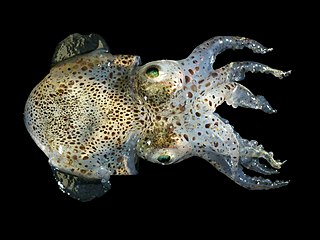
Bobtail squid are a group of cephalopods closely related to cuttlefish. Bobtail squid tend to have a rounder mantle than cuttlefish and have no cuttlebone. They have eight suckered arms and two tentacles and are generally quite small.
Orthogastropoda was a major taxonomic grouping of snails and slugs, an extremely large subclass within the huge class Gastropoda according to the older taxonomy of the Gastropoda.

The clade Cephalaspidea, also known as the headshield slugs and bubble snails, is a major taxon of sea slugs and bubble snails, marine gastropod mollusks within the larger clade Euopisthobranchia. Bubble shells is another common name for these families of marine gastropods, some of which have thin bubble-like shells. This clade contains more than 600 species.

Oegopsida is one of the two orders of squid in the superorder Decapodiformes, in the class Cephalopoda. Together with the Myopsina, it was formerly considered to be a suborder of the order Teuthida, in which case it was known as Oegopsina. This reclassification is due to Oegopsina and Myopsina not being demonstrated to form a clade.
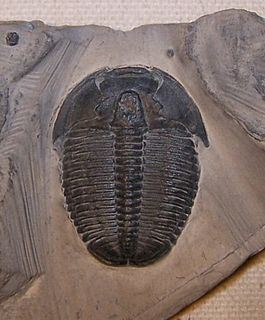
Ptychopariida is a large, heterogeneous order of trilobite containing some of the most primitive species known. The earliest species occurred in the second half of the Lower Cambrian, and the last species did not survive the Ordovician–Silurian extinction event.

Ammonitina comprises a diverse suborder of ammonite cephalopods that lived during the Jurassic and Cretaceous periods of the Mesozoic Era. They are excellent index fossils, and it is often possible to link the rock layer in which they are found to specific geological time periods.

The seven-arm octopus is one of the two largest known species of octopus; based on scientific records, it has a maximum estimated total length of 3.5 m (11 ft) and mass of 75 kg (165 lb). The only other similarly large extant species is the giant Pacific octopus, Enteroctopus dofleini.
The taxonomy of the Gastropoda, as revised by Winston Ponder and David R. Lindberg in 1997, is an older taxonomy of the class Gastropoda, the class of molluscs consisting of all snails and slugs. The full name of the work in which this taxonomy was published is Towards a phylogeny of gastropod molluscs: an analysis using morphological characters.

Neocoleoidea is a large group of marine cephalopods. This cohort contains two extant groups: Decapodiformes and Octopodiformes. Species within this group exist in all major habitats in the ocean, in both the southern and northern polar regions, and from intertidal zones to great depths. Whilst conventionally held to be monophyletic, the only morphological character for the group is the presence of suckers: although the presence of these features in the belemnites suggests that they do not support the Neocoleoidea, and hence that the group may be paraphyletic.

Phyllodocida is an order of polychaete worms in the subclass Aciculata. These worms are mostly marine though some are found in brackish water. Most are active benthic creatures, moving over the surface or burrowing in sediments, or living in cracks and crevices in bedrock. A few construct tubes in which they live and some are pelagic, swimming through the water column. There are estimated to be about 3,500 species in the order.
The taxonomy of invertebrates as proposed by Richard C. Brusca and Gary J. Brusca in 2003 is a system of classification with emphasis on the invertebrates, in other words, a way to classify animals, primarily those which have no backbone.
The taxonomy of the vertebrates presented by John Zachary Young in The Life of Vertebrates (1962) is a system of classification with emphasis on this group of animals.
Euheterodonta is an infraclass of Mollusca in the class Bivalvia.

Ovalentaria is a clade of ray-finned fishes within the Percomorpha, referred to as a subseries. It is made up of a group of fish families which are referred to in Fishes of the World's fifth edition as incertae sedis as well as the orders Mugiliformes, Cichliformes and Blenniiformes. It was named by W. L. Smith and T. J. Near in Wainwright et al. (2012) based on a molecular phylogeny, but the authors suggested that the group was united by the presence of demersal eggs that are attached to a substrate. Some authors have used the ordinal name Stiassnyiformes for a clade including Mugiloidei, Plesiopidae, Blenniiformes, Atherinomorpha, and Cichlidae, and this grouping does appear to be monophyletic.
